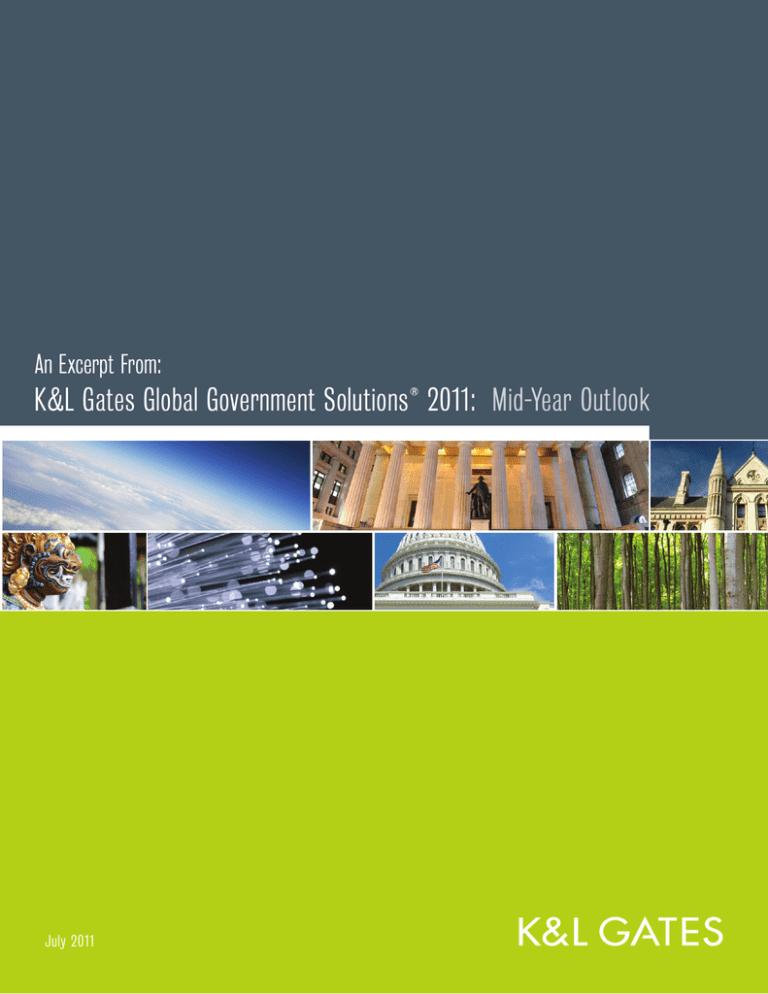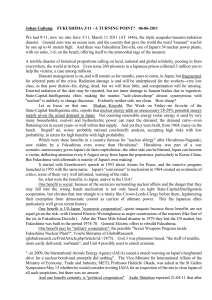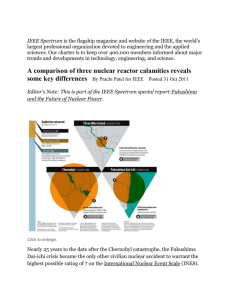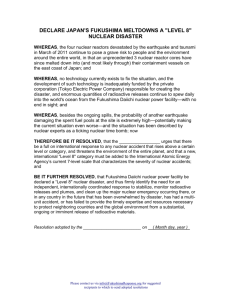
An Excerpt From:
K&L Gates Global Government Solutions ® 2011: Mid-Year Outlook
July 2011
Asia
Will Japan Fundamentally Change Its Energ y Policy?
What is the future of nuclear power in Japan? That is the question on everyone’s
mind following Japan’s so-called “Triple Disaster” beginning with the massive
earthquake and tsunami on March 11, 2011 and continuing with the ongoing
crisis at the Fukushima Daiichi Nuclear Power Station.
62
On April 12, a month after the
earthquake and tsunami, Japan’s Nuclear
and Industrial Safety Agency upgraded
the nuclear crisis at the Fukushima
plant to a level 7 event—the maximum
level on the International Nuclear and
Radiological Event Scale, and the same
level as the Chernobyl crisis. Since
then, there has been a steady trickle of
information from the Tokyo Electric Power
Company confirming expert opinions
around the world that the event was even
worse than it first appeared. Although
Fukushima was no Chernobyl, the name
Fukushima has now been added to the
lexicon of nuclear terms and will forever
be known as the place where one of the
world’s worst nuclear accidents occurred.
requested the shutdown of the Hamaoka
Nuclear Power Station run by the Chubu
Electric Power Co., Inc. (the electric
power company covering the middle
region of Japan). At first it was reported
that the closure would be ordered by
the government, but when it became
publicly known that the Hamaoka plant
was in compliance with the government’s
Nuclear and Industrial Safety Agency
standards, Japan’s prime minister was
forced to reduce his order to a “request.”
Nevertheless, notwithstanding the lack of
a legal basis for the closure and the fact
that the Hamaoka plant provides nearly
twice the energy output of the Fukushima
plant, Chubu Electric complied and shut
down the plant.
Ominously for the proponents of nuclear
power, the attention of the Japanese
government next focused on a nuclear
plant on the southern coast of Shikoku,
the smallest of Japan’s main islands,
more than 500 kilometers (310 miles)
away from the Fukushima plant. In an
apparent political move in response
to the Fukushima incident, on May 6
(just two months after the earthquake),
Japanese Prime Minister Naoto Kan
The publicly stated rationale for the
closure was that the government’s
Earthquake Research Committee
estimated that there is an 87 percent
chance that an earthquake of magnitude
8 would strike the area surrounding
the Hamaoka plant within the next 30
years, leading seismology experts to
claim that the Hamaoka plant is the
“most dangerous nuclear power plant in
Japan.” If this was the real reason for the
K&L Gates Global Government Solutions ® 2011 Mid-Year Outlook
closure of a plant so integral to Japan’s
power grid (and there is more than a
small amount of debate as to whether
it was just political grandstanding by
the prime minister in an effort to show
strong leadership), the future of the
nuclear power industry in the entire
country would be cast into doubt since,
according to some experts, every part
of the country is at risk of experiencing a
major earthquake in the next 30 years.
In closing the Hamaoka plant, however,
the prime minister did cite to legitimate
concerns that a nuclear crisis can bring,
such as consequential damages. The
Fukushima event has resulted not only
in the evacuation of an ever-expanding
area in proximity to the plant, but has
also brought rolling blackouts across the
region, bans on certain agricultural and
other products, and disruptions in global
supply chains—all of which have had a
severe negative impact on the Japanese
economy. Japanese companies such as
Sony Corporation have been forced to
temporarily close damaged plants. In
Sony’s case, this adversely affected the
company’s production of digital video
discs, lithium batteries, optical devices,
and other items that were sold throughout
the world. Japanese automakers such
as Toyota and Honda have been
temporarily forced to shut down
assembly plants in the United States,
Asia
The name Fukushima has now been added
to the lexicon of nuclear terms.
due to a shortage of parts (particularly
in engines and transmissions) resulting
from disruptions at factories in Japan
due to power shortages. Even as of this
writing, continues to be a general lack
of inventory for Japanese car dealerships
in the United States. Overall, Morgan
Stanley MUFG Co., Ltd. has forecast a
short and deep recession for Japan, with
the economy shrinking by 1 to 3 percent
in 2011, mostly due to these knock-on
effects and not to the damage caused by
the quake or the tsunami itself.
Not surprisingly, the Fukushima incident
is leading the government of Japan to
rethink its energy policy. In a country
known for consensus decision-making, it
is now widely said that nuclear power
is clearly not the best alternative in such
an earthquake-prone country. According
to the June 2010 Ministry of Economy,
Trade and Industry’s (METI) Strategic
Energy Plan of Japan, the Japanese
government was to build nine additional
nuclear plants by the year 2020 and
another five by the year 2030, which
would increase its nuclear energy
resources to 50 percent of all production.
However, recent actions by the Japanese
government, including the closure of the
Hamaoka plant, have indicated that
these plans will likely be scrapped. At an
Organisation for Economic Co-operation
and Development (“OECD”) gathering
on May 27, 2011, Prime Minister Kan
suggested that the government of Japan
needs to start from scratch with its energy
policy and begin focusing on increasing
the use of renewable energy resources
such as solar and wind power.
So the country is left to grapple with
finding an alternative to its planned
nuclear future. The well-known issues with
solar and wind energy resources are
their cost. According to 2010 statistics
provided by METI, nuclear power costs
between ¥5 and ¥6 per kilowatt hour,
while wind power costs between ¥10
and ¥14 and solar costs ¥49 per
kilowatt hour. Prime Minister Kan has
emphasized that he would like to raise
renewable energy resources to the level
of a “core” energy resource and will
attempt to reduce the costs of solar power
to a third of current levels by 2020 and
a sixth by 2030. Still, the Japanese
government has much work to do, as
solar and wind power currently only make
up about 1 percent of Japan’s total power
supply, as compared to nuclear energy,
which comprises 30 percent.
So where does this leave Japan? There
is little doubt that the Fukushima incident
has provoked a healthy discussion on
renewable energy resources, and that
Japan’s anti-nuclear movement may
have garnered nationwide support.
However, despite lingering questions
about the reasons for the closure of
the Hamaoka plant, it is unlikely that
Japan’s makeup of energy resources will
change anytime soon.
J. Ryan Dwyer, III (Tokyo)
ryan.dwyer@klgates.com
Grant S. Tanabe (Tokyo)
grant.tanabe@klgates.com
In the short term, a solution is likely to be
found by looking to Japan’s neighbor to
the north, Russia, and the vast supplies
of liquified natural gas to be found in
the Russian Far East. However, even this
alternative presents significant political,
legal, and logistical hurdles.
K&L Gates Global Government Solutions ® 2011 Mid-Year Outlook
63
Anchorage Austin Beijing Berlin Boston Brussels Charlotte Chicago Dallas Doha Dubai Fort Worth Frankfurt Harrisburg Hong Kong
London Los Angeles Miami Moscow Newark New York Orange County Palo Alto Paris Pittsburgh Portland Raleigh Research Triangle Park
San Diego San Francisco Seattle Shanghai Singapore Spokane/Coeur d’Alene Taipei Tokyo Warsaw Washington, D.C.
K&L Gates includes lawyers practicing out of 38 offices located in North America, Europe, Asia and the Middle
East, and represents numerous GLOBAL 500, FORTUNE 100, and FTSE 100 corporations, in addition to growth
and middle market companies, entrepreneurs, capital market participants and public sector entities. For more
information about K&L Gates or its locations and registrations, visit www.klgates.com.
This publication is for informational purposes and does not contain or convey legal advice. The information herein should not be used or relied upon in regard to
any particular facts or circumstances without first consulting a lawyer.
©2011 K&L Gates LLP. All Rights Reserved.






